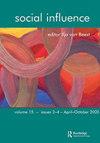“我要说服你!”-调查关于传播者属性和营销活动的明确说服的有效性
IF 0.6
3区 心理学
Q3 PSYCHOLOGY, SOCIAL
引用次数: 3
摘要
在显性说服中,传播者明确表达了说服消费者的愿望。参考归因方法,社会参与作为一个有益的传播者属性被同时探索,而与原因相关的营销(CRM)作为一个边界条件被解决。在一个实验中,我们改变了说服策略(显性vs隐性),传播者之前的社会参与经验(是vs否),以及具体的营销策略(CRM vs非慈善营销)。正如预期的那样,在非慈善营销条件下,当传播者有社会参与的经验时,显性说服比隐性说服更有效。在客户关系管理条件下,当沟通者先前有社会参与经验时,外显说服(与内隐说服相比)效果较差;当没有先前的经验报告时,说服力增强。本文章由计算机程序翻译,如有差异,请以英文原文为准。
‘I Want to Persuade You!’ – Investigating the effectiveness of explicit persuasion concerning attributes of the communicator and the marketing campaign
Abstract In explicit persuasion, the communicator states explicitly a desire to persuade the consumer. By referring to an attributional approach, social engagement was simultaneously explored as a beneficial communicator attribute, while cause-related marketing (CRM) was addressed as a boundary condition. In an experiment, we varied the persuasion strategy (explicit vs. implicit), the communicator’s prior experience with social engagement (yes vs. no), and the specific marketing strategy (CRM vs. non-charity marketing). As expected, in the non-charity marketing condition, explicit (vs. implicit) persuasion was more effective when the communicator had prior experience in social engagement. In the CRM condition, explicit (vs. implicit) persuasion was less effective when the communicator had prior experience in social engagement; when no prior experience was reported, persuasiveness increased.
求助全文
通过发布文献求助,成功后即可免费获取论文全文。
去求助
来源期刊

Social Influence
PSYCHOLOGY, SOCIAL-
CiteScore
1.50
自引率
0.00%
发文量
4
期刊介绍:
Social Influence is a journal that provides an integrated focus for research into this important, dynamic, and multi-disciplinary field. Topics covered include: conformity, norms, social influence tactics such as norm of reciprocity, authority, scarcity, interpersonal influence, persuasion, power, advertising, mass media effects, political persuasion, propaganda, comparative influence, compliance, minority influence, influence in groups, cultic influence, social movements, social contagions, rumors, resistance to influence, influence across cultures, and the history of influence research.
 求助内容:
求助内容: 应助结果提醒方式:
应助结果提醒方式:


